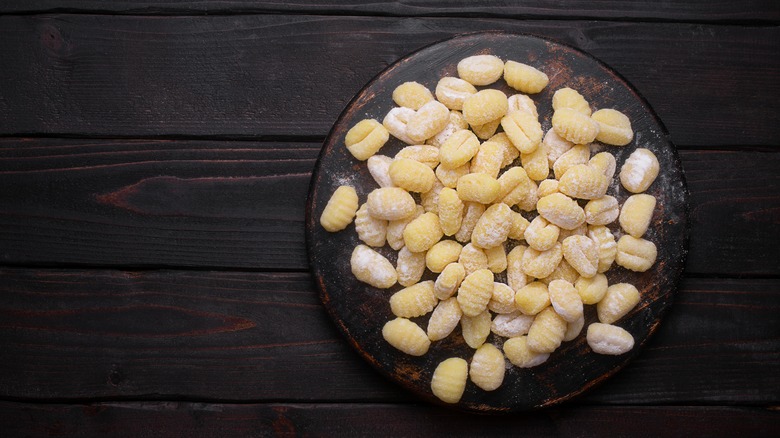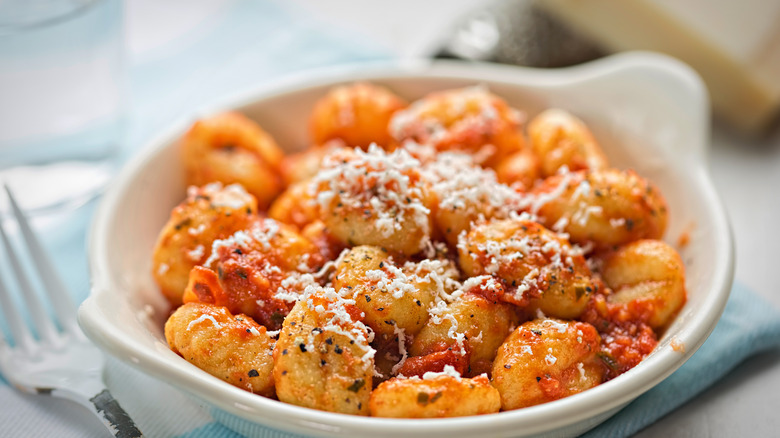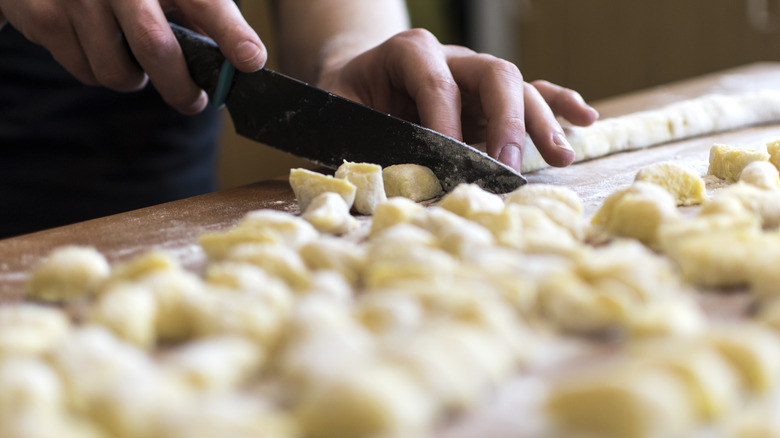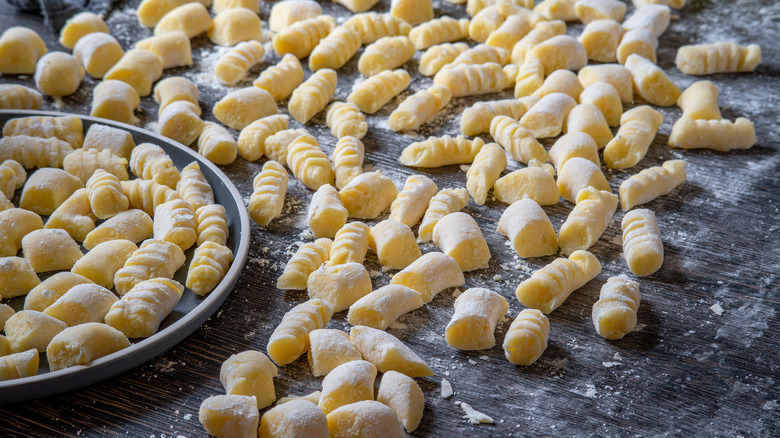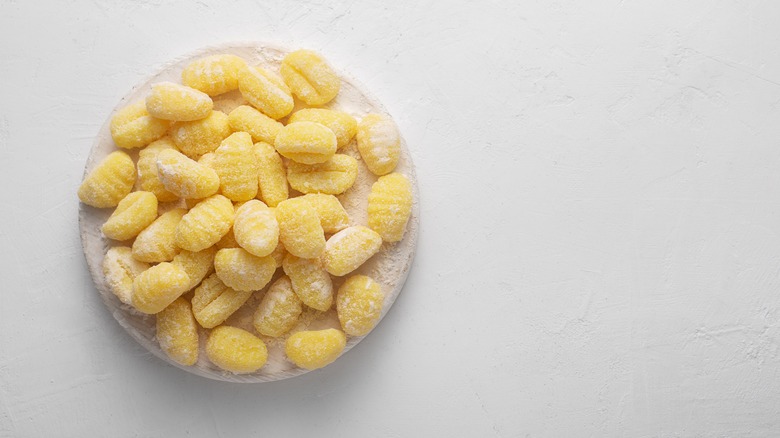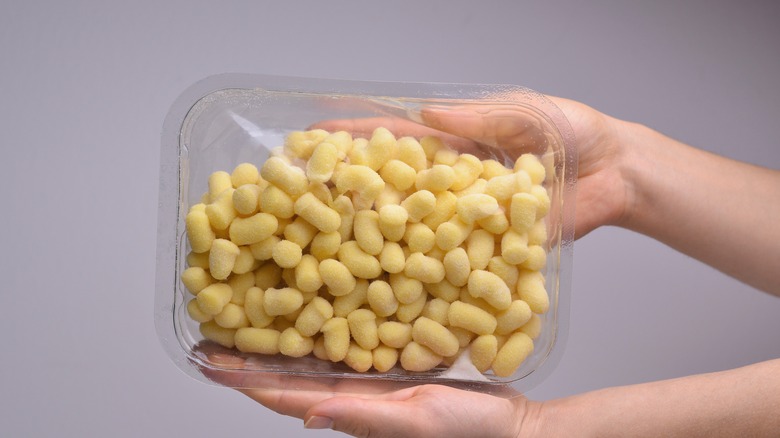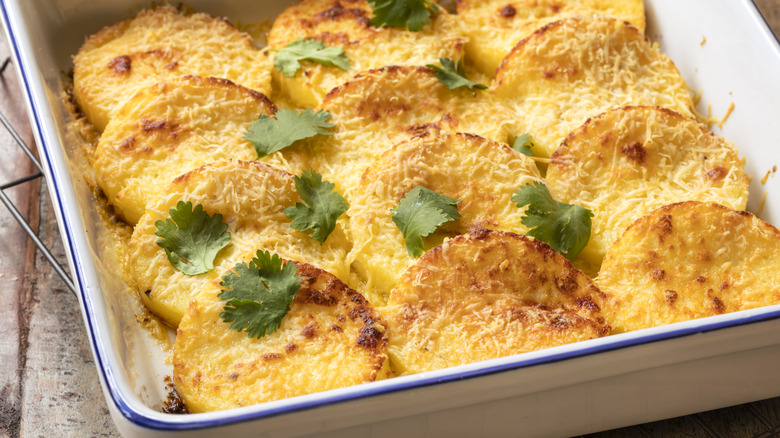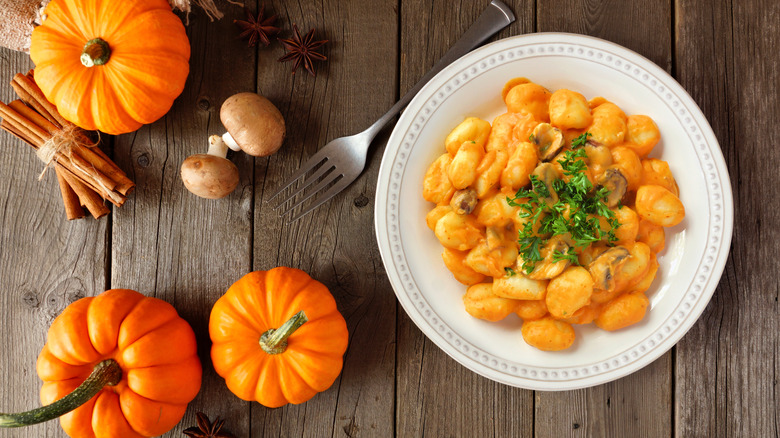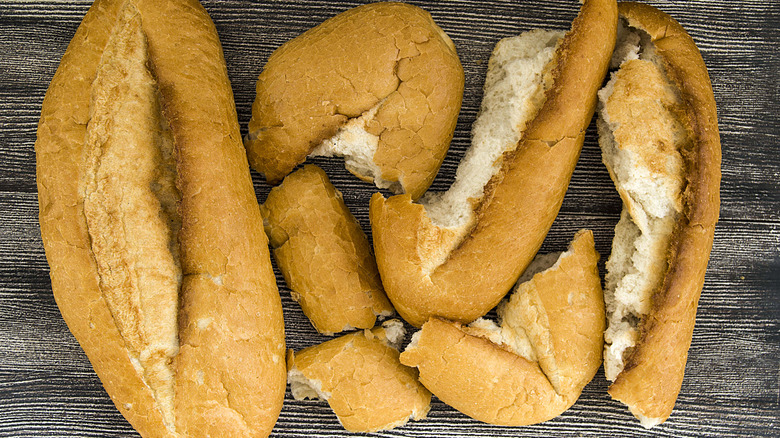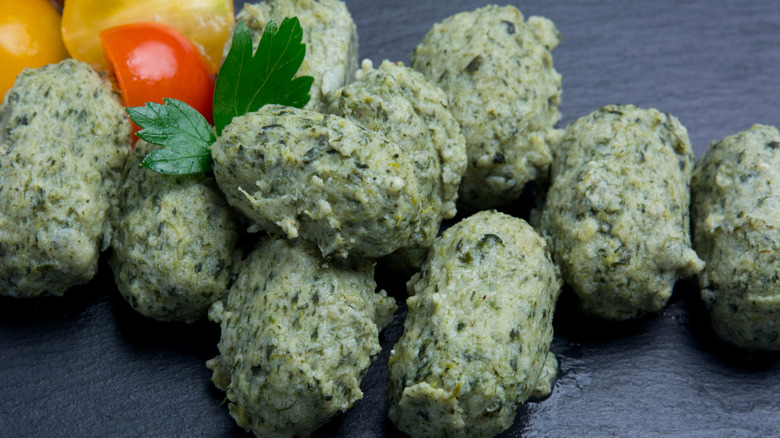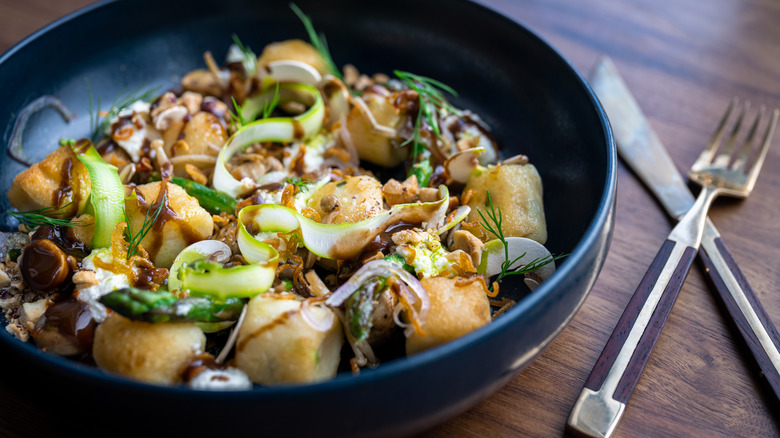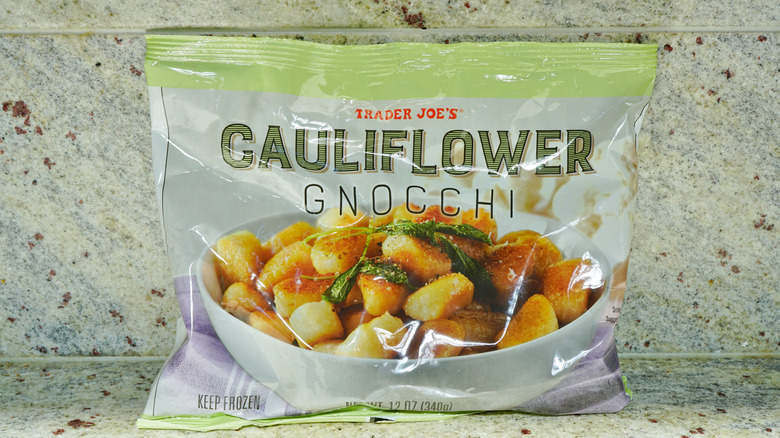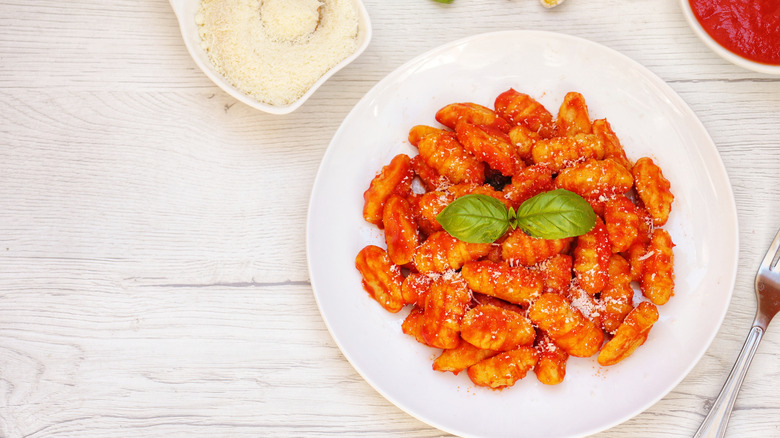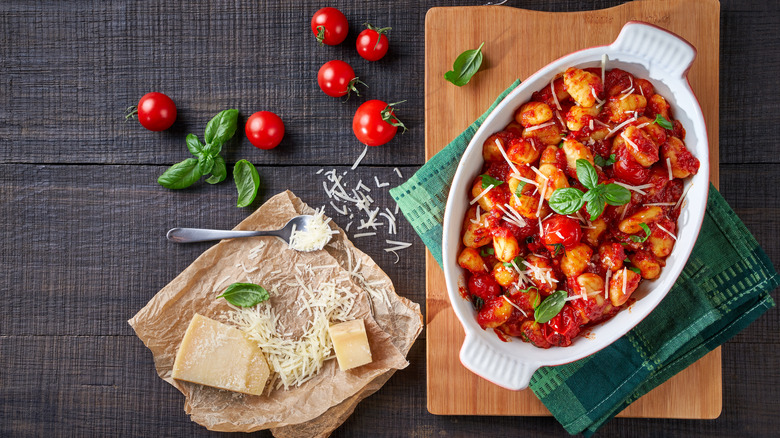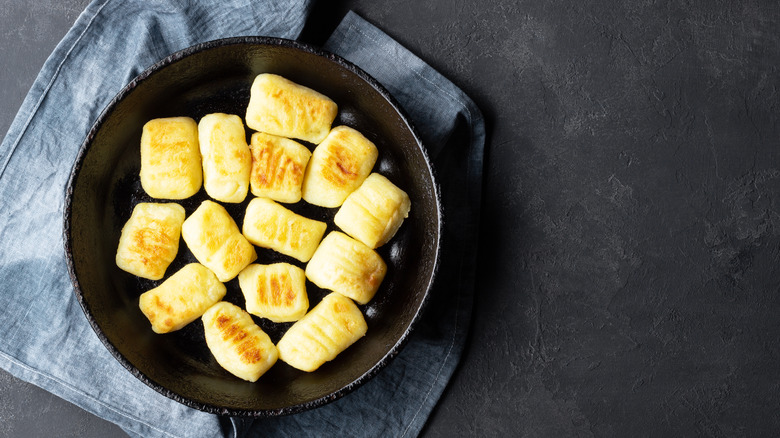The Untold Truth Of Gnocchi
Difficult to spell, tougher to pronounce, and almost impossible to get just right, gnocchi are certainly more persnickety than other starchy Italian staples like pasta or risotto. But these classic dumplings are well worth a closer look!
Gnocchi are perhaps the unsung hero of the Italian carb set, with a long, illustrious history that (spoiler alert!) predates that of pasta. With myriad forms ranging from the well-known potato iteration to variations made with everything from ricotta to semolina to cauliflower, these little dumplings, while often framed as a tasty stand-in for pasta, can actually more than stand on their own two feet.
Gnocchi are certainly tough to perfect, invariably emerging, as The Washington Post explores, either way too soft or way too tough (Saveur even cites a story first penned in the 19th century by Pellegrino Artusi that claims that the gnocchi of one woman disappeared into the pot she was cooking them in for want of sufficient flour). But when given time, patience, and a touch of technique, they are a wonderful addition to your kitchen arsenal.
Gnocchi may date back to Ancient Rome
For as often as Italian restaurant menus tend to pay mere lip service to gnocchi, slotting the dish into a laundry list of pastas and risottos, gnocchi deserves far much more time and space in the limelight, not in the least because it actually predates pasta.
The South China Morning Post asserts that the history of gnocchi dates back as far as Ancient Rome (and possibly even further back, to an undocumented but potential Middle Eastern ancestor). The first official gnocchi recipe, the outlet claims, can be attributed to Marcus Gavius Apicius in the 1st century of the Common Era. Of course, the outlet continues; this recipe didn't look exactly like the gnocchi we know and love today. Made with a mix of semolina flour and water or milk and seasoned with honey and black pepper, these gnocchi contained none of the potato so synonymous with the dish today–– and that makes sense! At the time, potatoes were a resolutely New World food that wouldn't arrive in Europe until the 16th century, according to the London Museum of Natural History.
Of course, this story isn't without its naysayers. Saveur notably points to a far more recent invention, dating the first gnocchi to the Renaissance. That said, the outlet admits that gnocchi "likely" existed much earlier than the elegant iterations that appeared on 15th-century banquet tables, though it doesn't pinpoint an exact potential origin point.
Gnocchi Friday is a real thing
Verona may be famous first and foremost as the hometown of Shakespeare's most illustrious star-crossed lovers, but the Italian city is also the site of one of the tastiest Friday night traditions: Gnocchi Friday.
The tradition, the South China Morning Post asserts, is linked to a famine that struck the city in 1531. It was at this point, due to food scarcity and untenable flour prices, that the rich deigned to distribute the kitchen staple to the poor. One such man, Tommaso da Vico, even added a line to his will stating that each year, his wealth should be used to distribute wine and ingredients for making gnocchi to the poor. (He had his priorities straight!)
Ever since, according to the outlet, the last Friday of Lent is the occasion for the Bacanal del Gnoco, an event that's part of the Verona Carnival. As part of the Bacanal, the Papà del Gnocco processes through the city, wielding a giant golden fork piercing a massive gnocco (the singular, by the way, of gnocchi).
Gnocchi is technically not pasta
While frequently slotted into the "pasta" section of restaurant menus, gnocchi deserves its own category — not in the least because, according to Saveur, gnocchi predates pasta by quite a few centuries.
Comparisons are natural. The South China Morning Post points to Alan Davidson's The Oxford Companion to Food, in which he writes that due to the similar dough of water and flour, as well as a similar way of serving them, doused with similar sauces, it's no wonder we conflate the two categories of starch. Even Italians can't seem to make the differences clear: In Venice, Saveur asserts, gnocchi is also sometimes known as "macaroni," and to add insult to injury, private chef Deborah Dal Fovo tells Lifehacker, that there's a food dubbed "gnocchetti" that is far more similar to pasta than to the tender gnocchi we know and love.
For Katie Barreira, test kitchen director of MyRecipes, however, the difference is clear: Gnocchi technically isn't pasta but rather, a dumpling. That said, even she waffles a bit on whether such a categorization is clear or useful. "I would ... put gnocchi in the dumpling camp from a culinary definition standpoint," she tells the outlet, "but it is treated as a pasta — from how it's cooked, to how it's sauced, and where it lands on a menu."
There are several theories as to the etymology of the word gnocchi
Difficult to spell and almost impossible to say, the word gnocchi boasts an interesting and convoluted etymology. Saveur reports that the word is thought to come from the Italian "nocca" or Lombard word "knohha," which it claims mean either knot or walnut, both of which would be ostensibly referencing the tight, gnarled shape of the dumpling. That said, the actual Italian word for walnut is noce, according to Collins Dictionary; the word in Italian for knot, meanwhile, is nodo.
Bottiglia, meanwhile, claims (and Lifehacker confirms) that, instead, that the word means "lumps," in Italian, a word Collins translates with myriad terms including a few bearing a slight similarity to gnocchi, including "bernoccolo," and a lot that don't, like "pezzo" or "zolla."
Giuliano Hazan asserts, instead, that the word is linked to the Italian for "knuckle," again, a reference to the dumpling's shape, which Collins translates as "nocca."
Potato gnocchi is the most common kind
When you think of gnocchi, you likely think of a light, soft dumpling made mainly with potato and bearing the tell-tale ridges that show it's been rolled along a wooden paddle and allow it to trap even more of whatever tasty sauce it's being served with. And indeed, this gnocchi variety is by far the most common today. According to Saveur, potato gnocchi first came to be in the 16th or 17th century, after Spanish explorers introduced South American potatoes to Italy. It's interesting to note that it's only one of several New Word foods that have since become synonymous with Italian cuisine, joining tomatoes, which CNN reports were only embraced in the 19th century, and zucchini, which Italians began cooking with gusto in the 18th century, according to Historic Geneva.
Amaro Bistro adds that since Northern Italian soils and climate were better suited to growing potatoes than grains, this style of gnocchi proliferated in this region, and today, it's no wonder that gnocchi is a particularly popular dish in the country's northern regions.
A few tips will help keep gnocchi light and fluffy
The most common woe in preparing potato gnocchi specifically is in keeping it light and fluffy instead of tough, a crime propagated by many a packaged version. According to Fine Cooking, however, there are a few steps you can take to ensure your homemade gnocchi are melt-in-your-mouth pillows of delight!
First off, start with the right kind of potato. Russet potatoes are known for their floury texture, the outlet asserts, and therefore make the lightest, most delicate gnocchi. Chef Marjorie Meek-Bradley of D.C.'s Ripple agrees, telling The Washington Post that "you need more starch than sugar" to get the dumplings just right, and a starchier potato like a russet or other baking potato is therefore your best bet.
Water is your enemy, in gnocchi-making, which is why Maren Epstein microwaves the potatoes at the heart of her potato gnocchi recipe. La Cucina Italiana adds that the potatoes should not be young but rather a bit older, due to the water content of a new potato demanding too much flour in later steps — but we'll get to that in a sec!
It's important, Fine Cooking asserts, to use the right tools. A ricer, rather than a potato masher, keeps the potato airy and light. And lastly, a bit of technique: gnocchi dough should never be overworked, and it's important to use as little flour as possible; the more flour you use, the more likely the gnocchi will become gummy, gluey, and glutinous.
In Rome, gnocchi is made with semolina
Potato gnocchi may be the most common, but as we've seen, they're not the original gnocchi — and they're not even the only gnocchi that exist in Italy today! Tons of different varieties can be found throughout the boot, and in Rome, locals have got a special place in their hearts (and on their plates) for a variety that mirrors the purported original. Indeed, it's a semolina flour-based gnocco that is used to make the perennial Roman classic gnocchi alla romana.
According to Chowhound, gnocchi alla romana begins with a dough that comes together on the stovetop. The resulting mix of semolina flour and seasonings is then rolled flat and cut into discs. These discs are, Giallo Zafferano asserts, layered into a baking dish, sprinkled with pecorino cheese, and drizzled with butter before being baked until crispy and golden. Thusly prepared, the outlet asserts, gnocchi alla romana is a classic Thursday evening offering on Roman tables!
Pumpkin gnocchi is common in Piedmont
Rome isn't the only city with its own gnocco. In the Northern Italian region of Piedmont, gnocchi are commonly made with yet another New World vegetable, pumpkin!
Pumpkin, according to Dolce Via, first arrived in Europe in the 16th century by way of Spanish sailors returning from South America. The squash was grown in Italy's Po Valley beginning in the 18th century, the outlet asserts, and in Piedmont, according to Gambero Rosso, pumpkins were soon incorporated into gnocchi dough for a soft, lightly orange dumpling.
In the Aosta Valley, the outlet contends, pumpkin gnocchi are frequently showered with fontina cheese — a local, semi-soft, washed rind cheese bearing a characteristic slight funk, according to the Spruce Eats. The resulting dish, according to Gambero Rosso, is baked au gratin.
Pumpkin is also a natural marriage with sage and butter, so it's no surprise that versions marrying these ingredients proliferate!
In some regions, gnocchi is made with stale bread
One common iteration of gnocchi that, according to Lifehacker, may be one of the earliest, dating to the 14th century, is a dumpling made with stale bread or breadcrumbs. Stale bread is a frequent culinary waste product that finds its way into many a "cucina povera" specialty, from panzanella salad to Tuscan ribollita soup. When it comes to bread-based gnocchi, a few versions exist, including one that Saveur notes dates to 15th century Lombardy and adds ground almonds to the mix. Dubbed "zanzarelli," these dumplings may have been quite a bit looser than modern gnocchi, if a recipe from Historical Italian Cooking is to be believed. The outlet calls for pouring a slurry of cheese, bread, and egg into a broth and cooking until set before serving sprinkled with baking spices.
These days, a dish known as "malfatti" (translating to poorly made) hearkens to those bread-based gnocchi roots. Usually flavored with spinach and enriched with egg, malfatti are far easier to make than more persnickety gnocchi, not in the least because, true to their name, they are even more charming when rustically formed.
Ricotta gnocchi is light and similar to gnudi
Other gnocchi rely, not on potato or squash or even bread, but rather on cheese — specifically ricotta — for a light, tender texture. Ricotta gnocchi are made with a combination of drained ricotta, eggs, and a mere touch of flour. According to Bigger Bolder Baking, they're even lighter than the best-made potato iteration.
For The Guardian, however, ricotta gnocchi aren't technically gnocchi at all. These dumplings are better known as "gnudi," a Florentine word that means "naked" and refers to their resemblance to a naked ravioli (aka all filling no pasta). Gnudi, the outlet asserts, can be made with or without flour, with the latter version bound merely by dusting briefly in semolina, as in this recipe from the BBC, resulting in a dumpling with an almost ethereal, ultra-fragile texture. Versions made with a bit of flour for binding, according to the Guardian, do indeed better resemble the gnocchi we've come to know and love.
Parisian gnocchi is pretty easy to make
While folks may associate gnocchi with Italy exclusively, there is an iteration made a bit further afield that bears mention. Parisian gnocchi, Serious Eats explains, hails from France and is made, not with potato, but with pâte à choux, the same dough used to make classic French pastries like cream puffs, éclairs, or profiteroles, not to mention that savory Burgundian specialty the gougère, a delicious eggy mouthful of grated cheese suspended in airy bliss.
Serious Eats compares Parisian gnocchi to a Chinese-style dumpling dough, made, as they are, on the stovetop with a hot water dough. Due to this step, the resulting dough is less elastic than most flour-based preparations and is easier to mold into little dumplings. Poached in water before being broiled in a skillet, these gnocchi, the outlet asserts, are super tasty tossed with squash and sage, Brussels sprouts and shallot, or tomatoes and corn. Or, you could go an ultra simple route and just serve them with butter and cheese for the ultimate comfort food!
Trader Joe's makes a popular gnocchi with cauliflower
After becoming a low-carb stand-in for everything from rice to mashed potatoes to pizza crust, Trader Joe's has introduced this miracle crucifer to gnocchi — and with great aplomb. After the product became Insta-famous in 2018, according to Cooking Light, the editorial team at the outlet took the product for a whirl. In a taste test comparing the cauli gnocchi to a more traditional store-bought potato iteration, Cooking Light found that while admittedly a bit sticky and gummy when stir-fried as suggested, the gnocchi proved particularly tasty when tossed with a simple butter sauce. While the cauliflower flavor definitely remains present, the outlet notes, it is a tasty and nutrient-dense tradeoff for more traditional potato gnocchi.
The distinctive, nutty flavor of cauliflower is actually set off to its best advantage when paired with other fall or winter produce, as in Sher Castellano's 15-minute fall gnocchi recipe, which sees the cauli-gnocchi married with kale and sweet potatoes and seasoned with sage, black pepper, and parmesan.
Gnocchi sauces are varied and often regionally specific
The base of your gnocchi is only half the battle: Like pasta, gnocchi is often served with a sauce, and also like pasta, the type of sauce you choose will depend on the kind of gnocchi you're making — as well as where you are on the boot.
In Sorrento, Saveur asserts, gnocchi are often served with tomato sauce, mozzarella, and basil; in the Alps, meanwhile, according to Gambero Rosso, they are often served with herbs, cured meat, cheese, mushrooms, and breadcrumbs browned in butter. And in Romagna, the outlet continues, gnocchi are frequently served with a green pea sauce or in a bean soup.
Verona's gnocchi, Saveur asserts, are most frequently served in a tomato sauce, though the simplest and most traditional method of presentation, according to Veronissima, is "abundant melted butter and even more abundant grated cheese." Sounds good to us!
You can bake gnocchi for a different texture
While as we've seen, some iterations of gnocchi such as gnocchi à la parisienne or gnocchi alla romana are always baked, even the classic potato iteration can be improved by a trip through the oven. This isn't necessarily the most traditional way to make and serve gnocchi, but it's certainly a fun play on the classic and, above all, a nice way to dress up a package of prepared gnocchi, which might otherwise be a bit tough.
The Kitchn suggests using gnocchi as the base for a vegetarian sheet-pan dinner with roasted vegetables, baking them until they get crispy and golden brown; in another, similar recipe, the roasted gnocchi are served on a bed of arugula for even more nutrients and flavor.
The Modern Proper, meanwhile, opts to bake gnocchi in a casserole with lasagna-like influences, simmering in a bubbling mass of sausage, ricotta, marinara, and mozzarella; this gnocchi bake, meanwhile, marries the dumplings with mushrooms, bacon, and a rich, creamy cheese sauce.
You can even fry gnocchi to make it crispy
If you want even more texture on your gnocchi, consider cooking them, not in boiling water, but in a frying pan! According to Easy Cheesy Vegetarian, frying packaged gnocchi lends it an improved texture that's crispy on the outside and fluffy within. While it takes a bit longer than boiling them, pan-frying in butter and oil for about 15 minutes, the outlet asserts, lends a golden-brown hue to the gnocchi, which can then be served with any sauce you like.
Easy Cheesy Vegetarian recommends serving fried gnocchi with a slightly thinner sauce, which just barely coats the crispy dumplings. And you can even go simpler than that, following Inside the Rustic Kitchen's lead and simply seasoning the fried gnocchi with fresh herbs, salt, and pepper for one of the easiest side dishes ever.
One thing to bear in mind, however: Trust Steve Ziegler's experience, and never attempt to deep-fry gnocchi. It's a true recipe for disaster!
